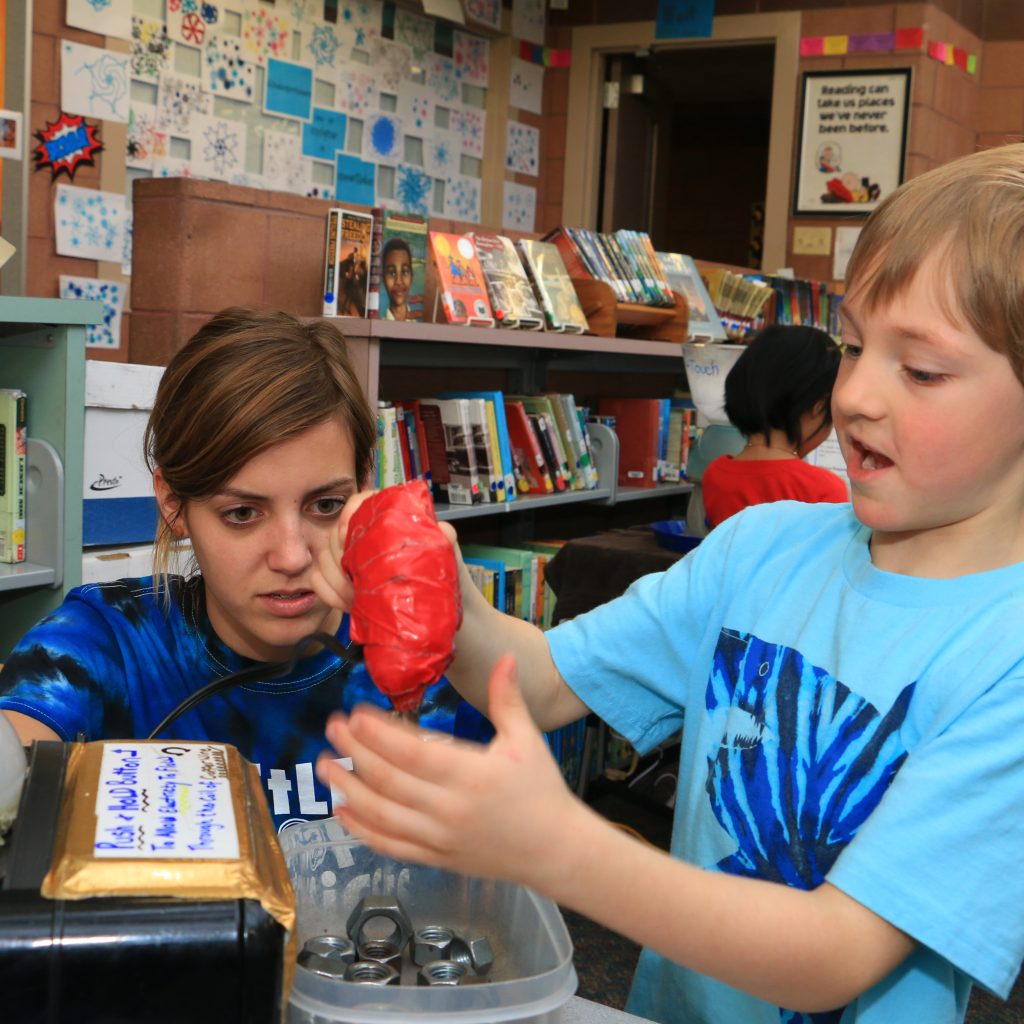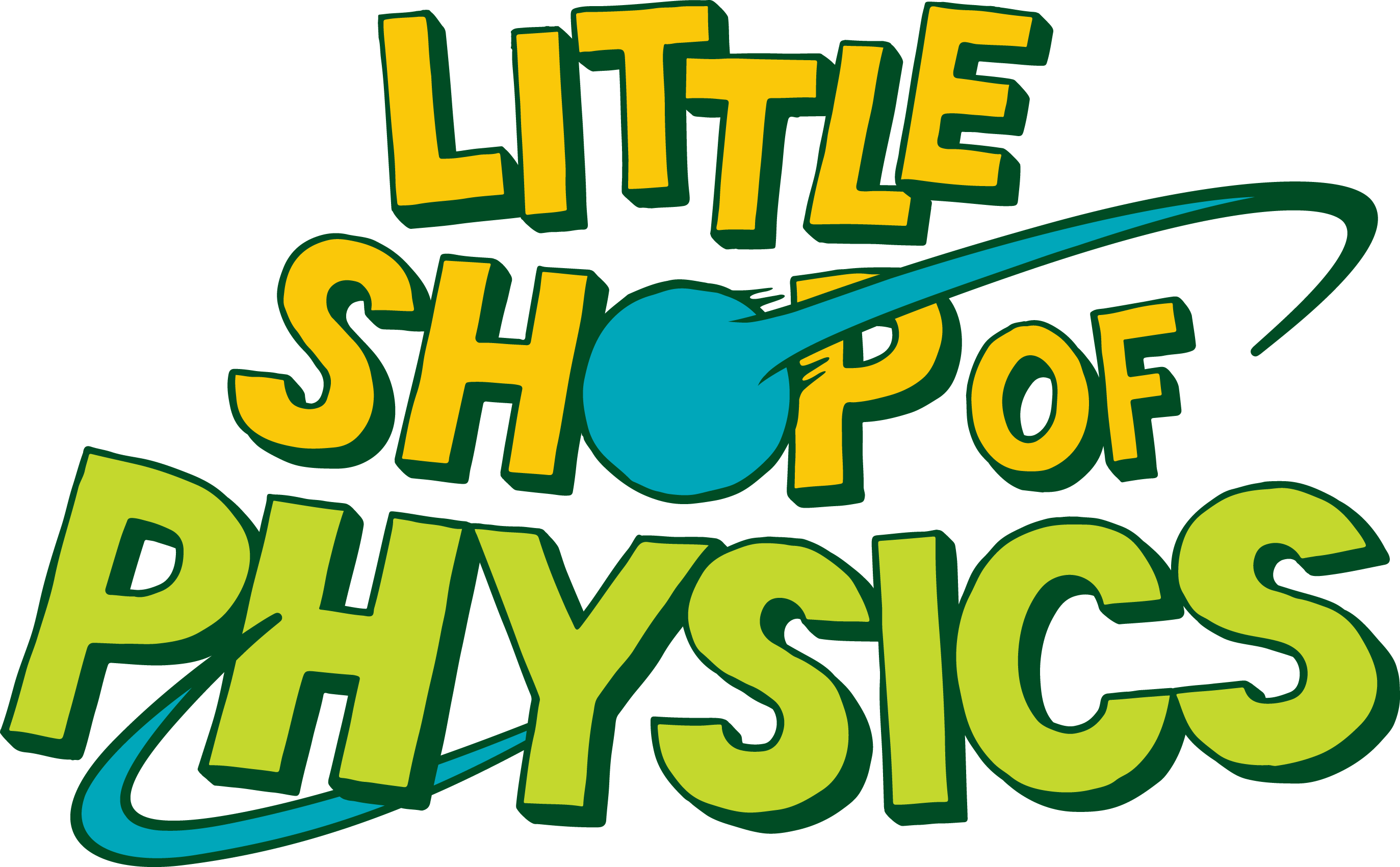Everything You Need to Know About Electricity
What happens when you plug a pickle into an electrical outlet? Just what is the “static” that makes your socks stick together when they come out of the dryer? Here we’ll explore electric charges, forces, and fields.
Electricity is almost certainly an integral part of your daily life. But how much do you know about the stuff that powers the screen you’re reading this on? On this page we’ve assembled a variety of resources to help you guide your students in an exploration of the principles of electric fields, potential difference (voltage), and electric current.
Theory
First, let’s establish some definitions and key principles. The basic physical units of electricity are charges. These entities can be positive or negative; there is a repulsive force between like charges and an attractive force between opposite charges. These are not two different forces, but rather a single long-range electric force (Felec); its agent is the electric field (E), a property of the region around a charge. The electric field increases in strength with decreasing distance from a charge, as does the electric force — stronger electric fields exert larger electric forces on charges. The electric fields of positive and negative charges are almost identical except for the crucial difference that they exert forces in opposite directions on a nearby charge of a given species (positive or negative). We’ll define everything we talk about from here on out in terms of positive charges — not the most convenient convention, as we’ll see, but a nearly universal one.
Because there is a repulsive force between like charges, you’d have to do work (W, energy input) to bring a positive test charge (a charge we imagine placing at different points to examine their properties) near another positive charge — the test charge wouldn’t move that way spontaneously; you’d have to somehow push it there. The work you’d have to do on the test charge would be converted to electric potential energy (Uelec) of the test charge. Since a positive test charge would have a high Uelec if it was pushed near a positive charge, we say that the region around the positive charge is one of high electric potential (V), regardless of whether another charge is actually present.
Similarly, you wouldn’t have to do any work to bring a positive test charge near a negative test charge. In fact, since there is an attractive force between opposite charges, the positive test charge would (in the absence of opposing forces) accelerate toward the negative charge. The positive test charge, then, gains kinetic energy (K) at the expense of Uelec as it nears the negative charge. We thus define the region around a negative charge as one of low V (again, whether or not there’s actually another charge present is irrelevant).
When positive charges are separated from negative charges, we say there is a potential difference, or voltage (∆V), across the region in between the positive and negative charges. Because the positive and negative charges are separated from one another, there is a net E in this region. It exerts a force on negative charges such that they are pushed away from other negative charges and toward positive charges, and vice-versa for positive charges. If the E exists in a conductor (a material in which charges don’t experience much resistance to their movement; compare with an insulator, in which the movement of charges is strongly inhibited), and if there is a conducting path through which the charges can return from whence they came (i.e., a complete circuit), there will be an electric current (I) — a flow of charges — in the region across which the ∆V is present. In reality, it is electrons (negative charges) which are free to roam in conductors; the protons (positive charges) are bound in atomic nuclei. However, it is conventional to define current as the flow of positive charges in diagrams and calculations, so we say that current flows from high V to low V (even though you know electrons are actually pushed from low to high V!).
We’re glad you’re still reading, because now we’re finally ready to answer our initial question: How does electricity power all our stuff? We know that as charges flow from high to low V, their Uelec is converted to K. Now, consider the case of water flowing downhill (as it does this, its gravitational potential energy, Ug, is converted to K): We can divert the flow and convert some of its energy to useful W for our own purposes instead of simply becoming K in the water. We can do much the same with an electric current as it flow from high to low V! The LEDs in your computer screen convert the energy in the electric current to photon energy, your toaster converts it to thermal energy… With this, we now know enough to jump into some explorations and experiments.
Application
What follows is a series of videos that can help you guide your students to an understanding of the basic principles of electricity. We’ve organized the videos in terms of “the 5 E’s”: Engage, Explore, Explain, Extend, and Evaluate. This structure has worked well for us in teacher workshops, and we hope it works well for you too! However, we always welcome your feedback. Please contact us anytime to let us know what’s working, what’s not, and how we can make this resource more useful for you. Enjoy!
Engage
The purpose of the Engage segment is to pique students’ interest. We don’t need to directly transmit concepts at this stage, merely give students a chance to think and get excited about the topic we’ll be discussing.
Video 1: Electric Pickle
If you do this demonstration yourself, DO NOT attempt it unless you have a GFI-protected cord!
A surprising and visually striking demonstration of electric current and power. When you plug into a wall outlet, one prong of the plug, and thus one wire, is “hot” (at high V); the other is “grounded” (at zero V), so current flows from the hot wire, through the electrical device it’s connected to, then back through the grounded wire, completing the circuit. To minimize the risk involved in this demonstration, we used a ground fault interruptor (GFI)-protected cable, such as that found on a hairdryer. After relieving the cable of the device it was connected to, we stripped the ends of each wire to bare the metal conductors inside the insulating coating. We then stuck each wire into one end of a medium-size whole pickle, thus creating a potential difference across it. The pickle is full of salty fluids — i.e., it’s a decent electrical conductor — so a current will flow across it. Some of the energy in the current is converted to thermal energy in the pickle, and some of it causes ionization of sodium atoms in the pickle. The result is a steaming pickle full of flashing yellow light!
Again: DO NOT do this with a non-GFI-protected cord! The GFI constantly tests the current in the two wires. If the amount of current headed back to the outlet from the device doesn’t match the amount sent into the device, indicating that something other than the device (for example, a human) has created a new conducting path to ground (i.e., if there is a ground fault), the GFI will immediately cut off the current from the outlet. A non-GFI-protected cord offers no such safeguard.
Video 2: Graphite Glow
An easy and surprising demonstration of the properties and effects of electric current. First, we connect four 9-volt batteries to one another to produce a ∆V of 36 volts. Then we attach one end of each of two alligator clips to a piece of 0.3mm mechanical pencil lead. Finally, attach the other end of one alligator clip to the free negative terminal, and the other end of the second alligator clip to the free positive terminal. Almost immediately, the segment of pencil lead between the clips will begin to glow and smoke (though you may have to adjust the spacing of the clips to get the best effect). The pencil “lead” is actually composed primarily of graphite; graphite is reasonably good at conducting electricity, but not nearly as good as the metal wires of the alligator clips. Thus the graphite acts as a resistor — it impedes the flow of electricity — and energy in the current is dissipated as thermal energy in the graphite.
Explore
In the explore segment, students get to experience firsthand the principles we hope to teach them. We still don’t need to explicitly describe any concepts yet — the students will start working these out as they explore.
Video 1: StaticSaurus
The construction of this project is a bit more involved, but it’s a fine exploration of the electric field. We connected the gate of a JFET transistor to a screw and completed an LED circuit by connecting the negative end of the LED to the transistor drain, the positive end of the LED to the positive end of a battery pack, and the negative end of the battery pack to the transistor source. Normally, the transistor doesn’t let current flow in this circuit, so the LED is off. But an electric field can flip the state of the transistor gate, allowing current to flow and turning the LED on. Where might you find an electric field? The easiest source is static electricity. Static electricity occurs when molecular bonds between surfaces are broken (e.g., due to the surfaces rubbing against one another). If one surface has a slightly higher affinity for electrons than the other, the former will leave the interaction negatively charged, the latter, positively charged. There is thus a net electric field — capable of turning on the LED — around each surface. This helps students begin to develop a sense of the electric field — when something is “charge-y,” the space around it is affected; this can have real effects on other electrical entities even if there’s no physical contact.
Video 2: Human-Powered Clock
Remember the electric pickle? Turns out, the human body is full of salty fluid too. This means that you and your students are all reasonable conductors of electricity. We can demonstrate this by incorporating you into a circuit with copper and galvanized steel pipe, a small battery-powered clock, and some wire. Galvanized steel is coated with zinc, which “wants” electrons less than copper does (i.e., zinc is less electronegative than copper). If there is a conducting path between a zinc surface and a copper one, a ∆V will be established and current will flow between them — current that, in this case, will power the clock. To accomplish this, you’ll wire one piece of galvanized steel pipe to the negative end of the battery connection in the clock (using solder or aluminum tape); wire one piece of copper pipe to the positive connection. Finally, wire a second piece of galvanized steel pipe to a second piece of copper pipe. Now, find two students and have each hold one copper pipe and one galvanized steel pipe — this completes the circuit, and the clock will turn on! (Make sure that one student isn’t holding both of the pipes that connect to the clock — though perhaps with your particular clock, this is sufficient! Experiment with it.)
Video 3: Electricity Part 3
Recall from the second Engage video that graphite, the stuff inside a pencil, is an electrical conductor. This means there’s a very simple, inexpensive way for your students to experiment with electrical circuits — just draw them! Any sort of paper will work, but we’ve found that it’s easiest to get enough graphite on the paper to make things go if you use a soft-leaded art pencil. In this video we use an “energy ball” toy with wires electrically connected (using aluminum tape) to the metal tabs you’re meant to place your fingers on as a probe of electrical conductivity. This is one option; another is to use a 9-volt battery as the power source in the circuit. If using the battery, a line will not suffice — students will need to draw a 2D shape (e.g., a circle or a square) and leave a small gap where they’ll touch the battery terminals to complete the circuit. Students can then use a multimeter to measure potential differences around the circuit, so this version of the activity lends itself well to more quantitative exploration of the electric field, the properties of resistors, and series and parallel circuits.
Explain
Now it’s time to codify and formalize the students’ observations. The following videos can help you elucidate and demonstrate the basic concepts underlying the discoveries students made as they explored.
Video: Electricity Part 1
An EveryDay Science introduction to the concepts of electric current and electric potential, and the idea that the transformation of energy which occurs as charges flow from high to low potential is what allows us to power devices in electric circuits. We demonstrate these phenomena on the by incorporating a couple of people into a circuit, a nice connection to the Human-Powered Clock students explored earlier.
Extend
Once the basic principles are clear, we want to encourage students to expand their thinking and ask questions that go beyond the scope of what we’ve already discussed.
Video 1: World’s Simplest Motor
A important corollary to the basic properties of electricity discussed thus far, and a demonstration that can serve as both an Extend to this topic and an Engage if you’re teaching magnetism next. (If this is the case, you’ll of course also want to check out Everything You Need to Know About Magnetism.) Electricity and magnetism are inextricably linked. Moving charges — i.e., electric currents — create magnetic fields which, analogous to electric fields, are the agent of the magnetic force. This means that a current-carrying wire will exert a force on a magnet (and vice-versa, of course) — a principle easily demonstrated with a battery, a magnet, a screw, and some wire.
Video 2: Horseshoe Magnet
A classic electromagnet. If you’re teaching magnetism after you wrap up with electricity, you’ll want this one on hand! As noted above, electric currents create magnetic fields. If you wrap a wire many times around a material that can be magnetized (in this project we use an iron horseshoe), then pass an electric current through the wire, you create a strong magnetic field inside the material, thus turning it into a magnet. This electromagnet will interact with other magnets and pick up other objects which can be magnetized — but only when current is flowing!
Evaluate
It’s important to figure out what students understand after the first four E’s. Tests and quizzes are one option, but there are many others.
This one is up to you — what works best for you and your students? We, for example, have had good results with turning the tables and letting the students make a video at this stage. We’d love to hear what works in your classroom!






